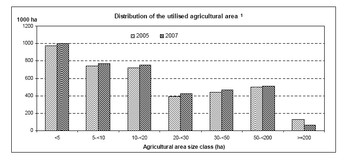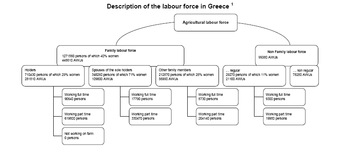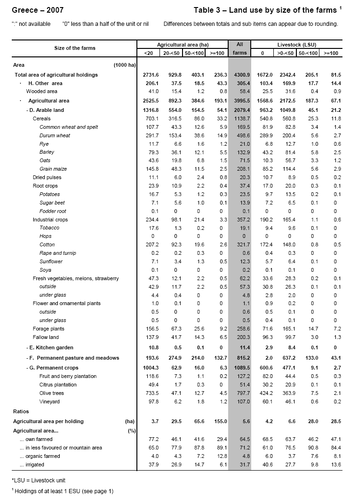Archive:Farm structure in Greece - 2007 results
- Data from December 2008. Most recent data: Further Eurostat information, Main tables and Database.
This article is part of a series of country-specific essays on the results of the European Union (EU) Farm structure survey (FSS) 2007. It provides a brief but nevertheless comprehensive insight into farm structure in Greece.
The 2007 FSS recorded 860 200 agricultural holdings in Greece, which represents a 4.8 % increase since 2005.
Main statistical findings
166 % increase in the area under organic farming
In 2007, about 711 100 agricultural holdings in Greece had an economic size of at least one European size unit (ESU), compared to 678 100 in 2005 (a 4.9 % increase).
These farms made use of 4.00 million hectares (ha) of utilised agricultural area (UAA), (2.3 % more than in 2005), which makes the average size of a holding in Greece 5.6 ha (compared with 8.1 ha in 2005). See Figure 1 for the distribution of UAA in terms of farm size, while Table 2 describes the size distribution and other characteristics of the agricultural holdings.
These holdings employed 548 000 annual work units (AWUs). The average area per AWU is 7.3 ha (around 0.5 ha more than in 2005). The organisation and distribution of the labour force in Greece is described in Figure 2 and Table 1.
The farms contained 2.6 million livestock units (LSU) in 2007, 6.1 % more than in 2005. The distribution of livestock by farm size is shown in Table 4 and Figure 3.
Amongst the 711 100 agricultural holdings in 2007:
- 70.8 % made use of less than one AWU, while another 7.1 % made use of two or more AWUs;
- 2 % produced mainly for own consumption and 26 % produced mainly for direct sales;
- 29 % of Greek farms specialised in olives, a 2 % increase compared with the 2005 value;
- 13 % of the holdings specialised in general field cropping;
- 12 % specialised in mixed cropping;
- 10 % of the holdings specialised in various crops and livestock combined;
- 10 % were specialised in cereals, oil seed and protein crops.
Amongst the sole holders:
- 29 % were women in 2007;
- 55 % were aged 55 or more and 8 % were younger than 35 years; and
- 20 % had another gainful activity in 2007.
In Greece in 2007, 65 % of the agricultural area was farmed by its owners.
The family labour force represents 82 % of the total labour force.
The area farmed under organic production methods increased by 166 % from 2005; in 2007 it counted for 5 % of the UAA, in 2005 only for 2 %. The average area of organic holdings was 7.1 ha. Details of land use by size of farm are given in Table 3.
71.2 % of the agricultural area was situated in less favoured or mountain areas in 2007.
There was an increase in fallow land (73 %) from 2005 to 2007.
There was a noticeable increase in the area used for common wheat and spelt (63 %), which went from 2.7 % of the UAA in 2005 to 4.2 % in 2007. On the other hand, the area sown with durum wheat also fell by a 1 quarter (-26 %). The area used for durum wheat diminished from 17 % (2005) to 13 % (2007) of the total UAA of Greece.
Industrial plants decreased by 10%, in particular tobacco plantations fell by 62 %.
The situation for subsistence farming in Greece is outlined in Table 5.
Data sources and availability
The National Statistical Service of Greece (NSSG), in collaboration with its 51 Regional Statistical Offices implemented the survey on the structure of agricultural holdings in Greece. The FSS 2007 was the third survey after the last Agricultural Census in 1999/2000. It was carried out between October and December 2007. The reference day for livestock was the 1st November and for the other characteristics, the reference period was from 1st October 2006 to September 2007.
The target population was all the holdings with at least 0.1 ha of UAA or 0.05 ha of greenhouses, or at least 1 cow, 2 other "large animals" (oxen, horses, donkeys or mules, 5 "small animals" (sheep, goats or pigs), 50 poultry, 20 beehives or 5 ostriches.
The sampling frame consisted of 854 302 holdings listed in the Statistical Farm Register, the outcome of the Agriculture Census 1999/2000 subsequently updated with administrative sources and with other agricultural statistical procedures carried out since the census.
The sample of 100 407 holdings (12 % of the population) was selected using a one stage stratified random sampling and the Neyman allocation method. The stratification criteria were the administrative districts (NUTS 3), for nine regions (NUTS 2) the fire stricken municipalities (of the August 2007 fires), the SGM and the typology. For new farms and organic ones the UAA was used for stratification. All farms with at least 38 ESU, new farms of at least 20 ha of UAA, farms and with special qualities (organic and ostrich farms), were surveyed exhaustively.
Altogether about 98 875 questionnaires were completed using a face-to-face interview.
Non-response in the 2007 FSS in Greece was quite low: 1.5 %. When the statistical information could not be collected, an additional sample replaced the missing holdings. Imputation and re-weighing was also used.
Between FSS 2005 and 2007 "maintaining land in good agricultural and environmental conditions" (GAEC) became an agricultural activity and the concerned land has been included in the agricultural area. In Greece it covers close to 11 300 ha, 95% in holdings with at least 1 ESU.
For each activity (`enterprise`) on a farm (for instance wheat, dairy cow or vineyard), a standard gross margin (SGM) is estimated, based on the area (or the number of heads) and a regional coefficient. The sum of such margins in a farm is its economic size, expressed in European size units (ESU, 1 ESU is a 1200-euro SGM).
An annual work unit (AWU) is equivalent to a worker employed on a full-time basis for one year. In Greece it is 2200 hours (275 working days of 8 working hours per day).
Context
European Commission rural development policy aims to improve competitiveness in agriculture and forestry, improve the environment and countryside, improve the quality of life in rural areas and encourage the diversification of rural economies.
As agriculture has modernised and the importance of industry and services within the economy has increased, so agriculture has become much less important as a source of jobs. Consequently, increasing emphasis is placed on the role farmers can play in rural development, including forestry, biodiversity, the diversification of the rural economy to create alternative jobs and environmental protection in rural areas.
The FSS continues to adapt to provide timely and relevant data to help analyse and follow these developments.
See also
Further Eurostat information
Publications
- Farm Structure Survey in Greece - 2007 - Statistics in focus 96/2009
- National Methodological Report - Farm Structure Survey 2005 - Greece
Main tables
- Agriculture, see:
- Farm structure: historical data (1990-2007) (t_ef)
Database
- Agriculture, see:
- Farm structure (ef)
Dedicated section
- Ad-hoc tables: Farm Structure Survey
Methodology / Metadata
- Farm structure (ESMS metadata file — ef_esms)







